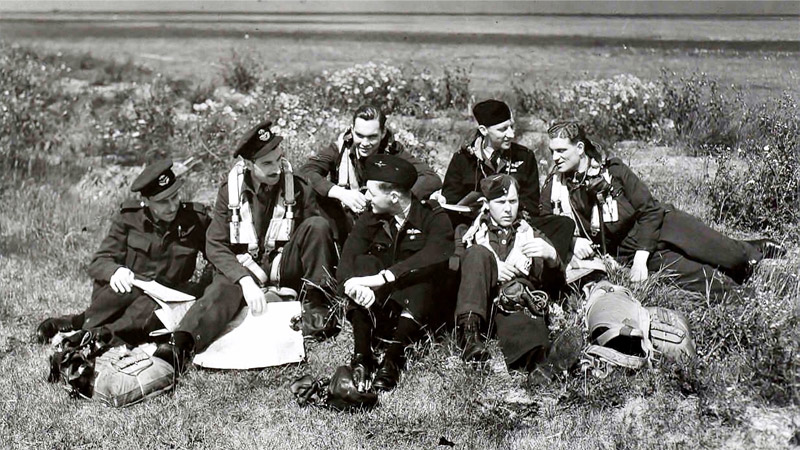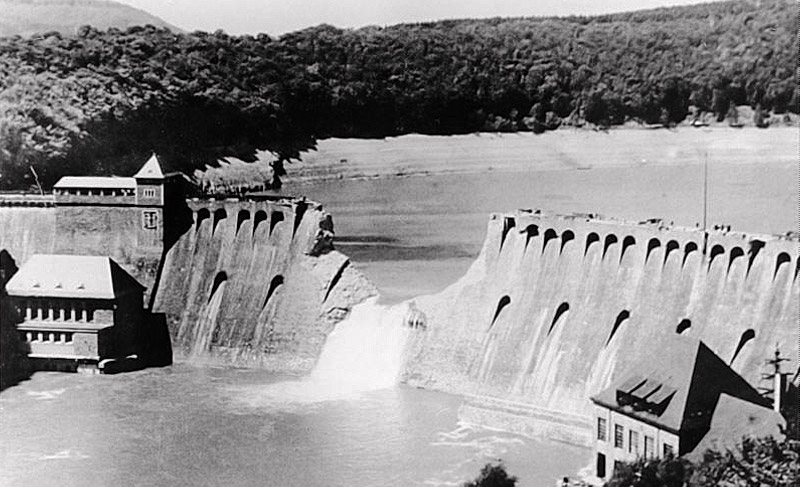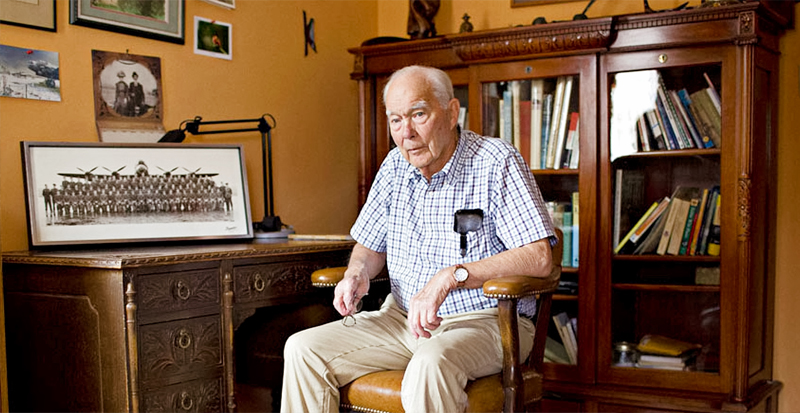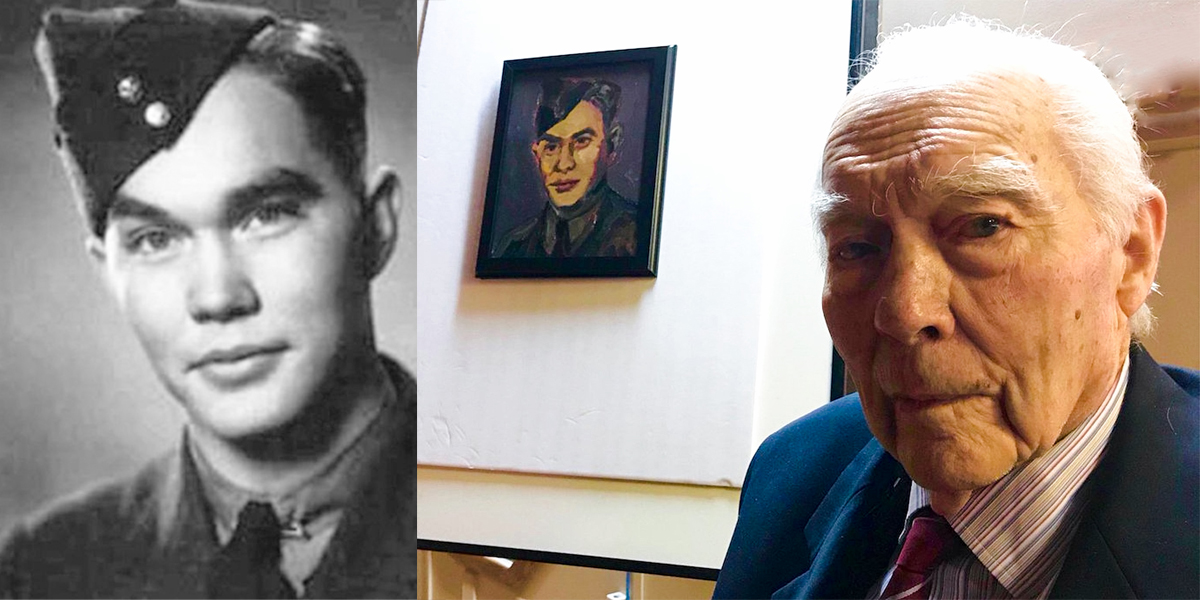Fred Sutherland, Canadian Dambuster gunner
Header image: Left: Fred Sutherland in wartime RCAF uniform.
Right: Fred in 2018 with his portrait, painted by Dan Llywelyn Hall.
Many readers will have seen the sad news that Canadian ‘Dambuster’ gunner, Fred Sutherland, passed away on Monday 21st January at the age of 95.
Long-standing members of the RAF Memorial Flight Club may remember that Fred generously provided us with his story for our 2013 Yearbook, which commemorated the 70th anniversary of the famous ‘Dams Raid’. He was the front gunner in Lancaster ED912 ‘AJ-N’, the aircraft captained by Australian Pilot Officer Les Knight that broke the Eder Dam with its Upkeep ‘bouncing bomb’ on the night of 16/17th May 1943. It was one of only 11, from the 19 despatched, which returned safely to England.
As a very modest man who did not relish the ‘limelight’, Fred Sutherland was initially reluctant to contribute to the publication of the story of his own personal experiences, confiding to the Editor that most of the time he could put the war out of his mind, but when he tried to recall it he always lost some sleep. Even so, recognising the importance of commemorating his wartime colleagues, especially those who paid the ultimate price, he generously agreed to help in the publication of his amazing story. The result was the first telling of the story of the ‘Dams Raid’ from his perspective, of his subsequent experiences of baling out over enemy territory on 617 Squadron’s disastrous Dortmund-Ems canal operation of 15th September 1943, and of evading capture to return home. When he received a copy of the magazine with his story he was very pleased with it and shared it with all of his family.
Fred Sutherland was born in Alberta, Canada, on 26th February 1923. His father was a doctor and his mother a nurse of Cree Indian descent. Fred joined the Royal Canadian Air Force (RCAF) in July 1941, aged 18. When an air gunners’ course came up he immediately volunteered, saying, “My hurry was that I thought the war would be over before I got there”. After arriving in England in spring 1942 he joined the crew of Sergeant Les Knight (RAAF) at 1654 Conversion Unit at Wigsley, as their mid-upper gunner. The rear gunner was Sergeant Harry O’Brien, from Saskatchewan, nicknamed ‘Obie’. Fred said: “Obie and I were two unattached youngsters; we consumed a lot of beer and we got quite a reputation for being rather wild.” Of their captain, Les Knight, Fred said: “Les was short but very muscular, strong in the shoulders and arms. He was a wonderful pilot, we all had the utmost confidence in his skills and his quick grasp of a problem in an emergency. He was very quiet but quick to act without panic when action was required. He was an example to us all and he was a good disciplinarian. We respected and admired him; he was just a wonderful person.”

When their training was complete the crew joined 50 Squadron at Skellingthorpe, Lincolnshire, and flew 25 ‘ops’ over Germany, before being asked to join the newly-forming 617 Squadron for a special operation. Fred said: “We were told we could stay together as a crew and we would be credited with a full tour of ‘ops’. We liked each other and didn’t want to start over again with a ‘green’ pilot and a brand new crew.”

Fred remembered the lengthy briefing for the ‘Dams Raid’, when the targets were revealed to him for the first time. He particularly remembered Wing Commander Guy Gibson’s ‘pep’ talk during which he said, “If you don’t do it tonight, you’re going back tomorrow night”. On the operation Les Knight and his crew observed events at the Mohne Dam and then successfully breached the Eder Dam with the last available Upkeep mine, subsequently returning safely to Scampton. Sitting in the nose of the Lancaster Fred had a grandstand view of the difficult and dangerous attack run against the Eder Dam. He told the Editor: “At the time I didn’t appreciate the skill and luck involved, but I was very proud to be part of that particular crew. Jumping over the hill and hitting the right speed and the right height was an act of genius."

Having survived against the odds, the crew’s luck ran out on the night of the 15th September 1943, during the disastrous low-level Dortmund-Ems canal operation, on which 617 Squadron lost five aircraft and crews from the eight despatched. In the target area mist obscured the ground and Les Knight’s Lancaster hit some trees on a small ridge as they searched for the target. It staggered away with a damaged tail and both port engines failing. Shortly afterwards one of the starboard engines also failed. The crew baled out, but Les Knight was still in the aircraft when it crashed and he was killed.
Five of the crew managed to evade capture and were eventually returned to England with the help of Resistance workers on the Continent. Fred said: “I cannot say enough about the people who helped me escape. This was at a time when the Germans had infiltrated the Underground and the whole organization had broken down. The people who helped us did so at tremendous risk to themselves; if they were caught they were dead, along with their family. I am at a loss to describe the kind of courage these people have. I am grateful and I will admire them as long as I am here.” Fred eventually crossed the Pyrenees into Spain and was flown back to England from Gibraltar at the end of November 1943. Subsequently he was not allowed to return to operations and spent the remainder of the war as a gunnery instructor back in Canada.

Fred Sutherland was a remarkable, kind and modest man. He was a reluctant hero, particularly keen to play down his own part in the war, insisting that those who joined 617 Squadron later on were the brave ones. “Those people joined the Squadron knowing its reputation. Those men had real courage and deserve a lot of credit. There was some wonderful work done later by 617 Squadron.”
With the passing of Fred Sutherland there is now only one of the original ‘Dambusters’ left alive, 97-year-old bomb aimer George ‘Johnny’ Johnson MBE DFM.







